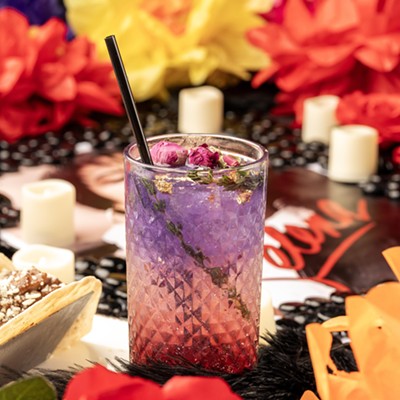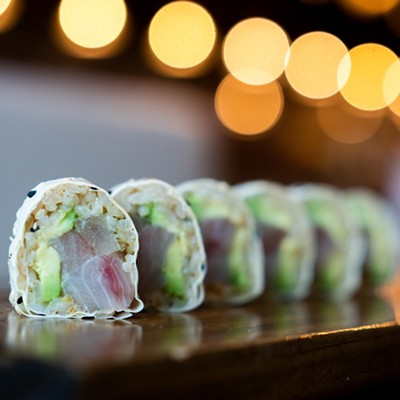Although it's all the craze lately, ramen is just one of the soups you'll find in Japanese cuisine. And although you'll find sushi everywhere these days -- from gas stations to grocery stores -- there's more to Japanese food than raw fish and rice.
And while Houston may have far fewer Japanese restaurants than Vietnamese or Chinese, the Japanese food we're running down today is relatively easy to find in the Bayou City -- from super-casual joints like Cafe Kubo's to high-end haute cuisine at Kata Robata, we've [almost] got it all.
The list of dishes below is just a jumping-off point for Westerners (fitting, as many of the dishes, ingredients and preparation techniques were originally adapted from European influences despite Japan's famously isolationist policies in the past), and therefore only a slice of the delicious fare the nation has to offer. But what a tasty slice it is.
Agedashi tofu
In Asian cuisines -- Japanese cuisine included -- tofu isn't a meat replacement to be tolerated, but an ingredient of its own to be celebrated. My favorite form of tofu in any cuisine is the Japanese appetizer called agedashi (pronounced: ah-guh-dah-shee) tofu. Cubes of semi-firm tofu are battered in potato starch and deep fried, which gives them the same textural appeal of twice-fried frites: crunchy outside, soft interior. They're served in a sauce that combines all the best savory umami flavors (umami is the sensation of food tasting earthy, rich and meaty) of dashi, mirin, and shoyu (a.k.a. soy sauce) and then topped with green onions for a tangy bite. Many dishes of agedashi tofu are also scattered with bonito flakes, which appear to "dance" as they melt into the hot tofu and give the whole dish a final sweet, briny note.
Chawanmushi
Imagine savory egg custard or flan. That's chawanmushi, which also incorporates those same umami-rich sauces as agedashi tofu. Dashi, mirin and soy sauce are mixed into eggs alongside mushrooms and shrimp. The whole thing is steamed inside a container no larger than a teacup ("chawan" means small bowl), but can be served hot or cold. I prefer my chawanmushi hot -- especially in the winter -- and those not practiced with using chopsticks will prefer this dish for another reason: It's always eaten with a spoon.
Karaage
Americans like to think we have the market cornered on fried chicken. If you're in that camp, I invite you to try the Korean fried chicken at Toreore, the Hong Kong chicken wings at House of Bowls or karaage -- Japanese fried chicken -- at Muishii Makirritos. Karaage (pronounced: car-RAH-gay) can technically be any fried meat, but you'll encounter chicken karaage most often. The fowl will usually have been marinated in a mixture of garlic, ginger and soy sauce, then battered in more potato starch and deep fried. Ever since they were introduced during the Edo Period as a convenient form of fast/street food, fried dishes -- called agemono as a group -- have been popular in Japan although the batter and technique varies, from tempura to karaage to tonkatsu.
Tonkatsu
At its simplest, tonkatsu is breaded, deep-fried pork cutlet. Unlike tempura or karaage, tonkatsu is breaded using panko for a fine, crumbly texture to the batter. Tonkatsu can be served on its own, but it's frequently found under curry (brought to Japan via England via India, for a very watered-down and non-spicy version of the original spice blend) alongside steamed rice, but can also be a sandwich filling. It's also popular in a hybrid dish called katsu-don, which pairs the tonkatsu and its sweet, vinegar-y sauce with a rice bowl (called donburi) and plops an egg on top.
Udon
Not to be confused with donburi, udon is a noodle soup (and a noodle soup that's not to be confused with ramen). Got it? In its most basic form, udon is simply a bowl of thick wheat flour noodles in a broth made with dashi, mirin and soy sauce. It's most commonly topped with fried meat or seafood, scallions and fish cakes called kamaboko. The extra thick, jiggly udon noodles are easily the most slurpable noodles you'll find in Japanese cuisine.
Soba
Like udon, soba noodles are a popular alternative to rice. Unlike udon, soba noodles are made from buckwheat and can be served hot or cold. Chilled soba noodles are usually served separate from the tsuyu broth, which you use to dip your cold noodles into, as many fans of soba say that the texture is best when the noodles haven't been sitting in warm soup. Hot soba dishes are served in a thinner version of the tsuyu, and can be topped with anything from fried shrimp to raw eggs that cook in the broth.
Gyoza
Gyoza go by many names from culture to culture; they're the dumplings that are also called jiaozi in China or pierogie in Poland or manti in Turkey. In Japan, gyoza are usually filled with pork, cabbage, garlic and ginger. They're pan fried to give one side a crispy texture, then steamed to finish. As with tempura and tonkatsu, gyoza were adapted from a foreign cuisine (Chinese, in this case) but are considered "Japanese" by now.
Umeshu
Umeshu has an unusually sweet, floral fragrance and taste that comes from steeping the ume fruit (which is halfway between a plum and an apricot) in alcohol and sugar until fermented. The result is a liquer that's between 10 and 15 percent ABV, so this isn't something you drink throughout a meal. I think of umeshu (pronounced: woo-MAY-shoo) as a cousin to sherry or Port, and consume it in a similar fashion.
Sake
Although you may have seen sake called "rice wine," it's truly more like "rice beer." Rice is fermented to make Japan's most popular alcoholic beverage, but there are far more factors at play than just that. The many varieties of sake are differentiated by the type of rice used, how long it was polished, how long the sake ferments, what water is used, how long the sake matures and how filtered the sake is before it's bottled. Sake can be filtered or unfiltered, dry or sweet, fruity or floral and can be served hot or cold. There are simply too many iterations on this fascinating beverage to list, so seek out a sake expert and dive in for yourself if you're interested -- it's rich, underexplored territory in the United States.
Where to get started:
Cafe Kubo's: One of the hippest and yet most laid-back places to spend an evening in Chinatown is at Cafe Kubo's, the younger and far more mod sister of the staid Kubo's in Rice Village. Instead of focusing on sushi, however, Cafe Kubo's offers a much more traditional Japanese fast-food menu of dishes like curried pork cutlets over rice, bento boxes of fried chicken and bowls of tonkatsu ramen that complement its casual vibe. Happy hour runs every day of the week here, and the food and drink specials make it a huge draw in the evenings.
Kubo's: The second-story location in the Rice Village can be difficult to find, but if you're a sushi lover, Kubo's is worth the hunt. While chef Hajime Kubokawa -- or Kubo-san, for short -- is no longer at the sushi restaurant he helped found with owner Yoichi 'Yogi' Ueno, nor is Manabu Horiuchi (who is setting the sushi world on fire at Kata Robata), it's still one of the best sushi joints in the city, a fact that's more impressive considering its longevity and the talent that's come through since the place opened in 2002. Try the daily specials for interesting fish finds like idiot fish, or order the enormous sashimi boat if you've got a group of people to impress. On the non-sushi side, the chawanmushi is the best in town and the bar scene is lively when filled with Japanese businessmen in the evenings.
Kata Robata: Sushi chef Hori-san is serving some stellar sushi and stunningly inventive dishes here in Upper Kirby. Granted, the fabulous stuff doesn't come cheap. But if you're on a budget, go to Kata Robata during happy hour when you can eat inexpensive grilled dishes off the robata and drink cheap beer.
Genji: If you're looking for a good time and fantastic Japanese bar food, Genji is the only show in town. Set to the soundtrack of some serious (and sometimes seriously painful) karaoke, Genji attracts businessmen and twentysomethings alike. Menu highlights include teba gyoza (stuffed chicken wings), onigiri (rice balls), beef kushiyaki and yakisoba (pan-fried noodles with a fried egg on top).
Nippon: Nippon has been serving Montrose residents (and expat Japanese) their sushi for decades, and has never failed in that time to serve the freshest fish it can get. The uni here always tastes like a buttery gulp of the sea, and standards like fatty salmon nigiri are marbled and thickly cut. The rolls are also predictably good, like the spider roll stuffed with soft-shell crab, and so is the pork-thickened ramen.
Shabu House: Shabu shabu is a Japanese soup not unlike the Chinese hot pot. At Shabu House, you can sit at one of the 28 places at the horseshoe-shaped bar. In front of each seat is a burner with a pot of boiling broth in which you cook your food. The broth is made with kelp and tastes like miso. Choose ultra-thin slices of certified Angus beef, a seafood platter or, best of all, a combo of both. All soups come with ample veggies and glass noodles. This is a great place to go with a crowd.
Follow Eating Our Words on Facebook and on Twitter @EatingOurWords





